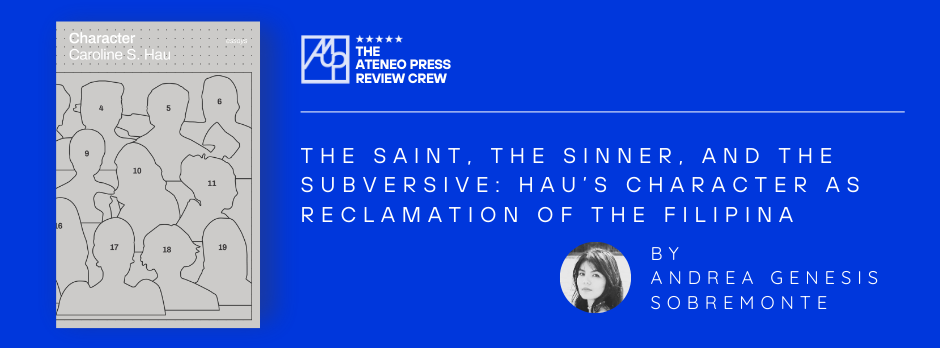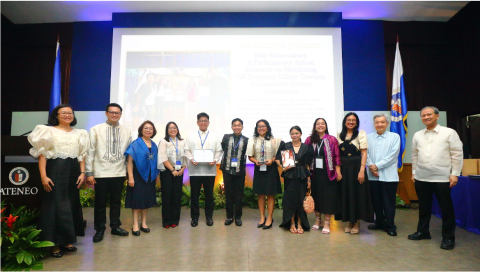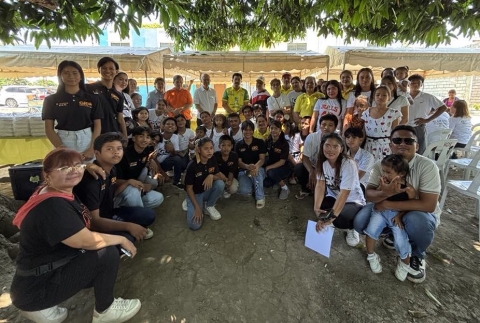[Ateneo Press Review Crew] The Saint, The Sinner, and the Subversive: Hau’s Character as Reclamation of the Filipina
21 Apr 2025 | Andrea Genesis Sobremonte
Caroline Hau’s Character is a work meant to be excavated. In her collection of essays, she cements meaning in figures that populate literature, history, and public imagination. What lingers the most in this pursuit is its insistence that the personal and political are never truly separate. And may it be in the literary and moral sense, Hau invites readers to a reexamination of identities that move between fiction and history, self and society, and the local and global.
Among the many subjects—a former president’s mistress, lifestyle gurus, Rizal’s heroine, and the “outlier” Philippines—Hau, with her reimaginings, reminds us why it is essential to read works written by women. Historically, women’s voices have been framed by the perspectives of men. When women write, they write to redeem the authority to shape their stories, challenge the limitations imposed upon them, and complicate the roles that history and literature have assigned them. To engage with her work and with the work of other women writers is to challenge the silences of the past and to participate in the ongoing dialogue about who gets to be remembered, how, and why.
Upon my reflection on the book, I found that if I were to distill 'Character' into a single truth, it is this: identity is not just inherited—it is fought for. I chose 'The Afterlives of Maria Clara,' 'The Querida Question,' and 'Gendered, Familial Lives, because they reveal how the past lingers with the present—not as a static label or relic, but something women must grapple with and redefine. What stood out the most with these featured essays is that they form a portrait of the Filipina—the saintly woman who is haunted by history, the shunned woman who is constrained by culture, and the transgressive explorer who is perpetually rewriting her own narrative. With these retellings, Hau does not simply mourn what has been imposed upon women; she also celebrates their protest, their survival, and their endless capacity to reclaim themselves.
The Afterlives of Maria Clara
In the essay entitled ‘The Afterlives of Maria Clara,’ the quintessential heroine of Rizal’s Noli, has transcended to be a phantom or (and?) phantasm that lingers in the Filipino consciousness. As a specter who is shaped and reassembled, Maria Clara is both myth and merchandise; her name is imprinted into cross-stitch kits, bottled in spiced vinegar, and painted onto the labels of wine meant to stain lips red. She has become a brand and a commodity, worn and traded. Despite these reinventions, Rizal’s Noli Me Tangere still haunts Maria Clara. It presents itself as a paradox with the claim that “nothing more was known” of Maria Clara while simultaneously ensuring that she is never truly forgotten.
In the hands of feminism and through the eyes of Hau, her transformation is also no accident. The centuries of colonial rule and the enduring grip of a patriarchal gaze insist on making Maria Clara a vessel of virtues imposed upon her by those in power. She is less of a woman and more of a mold—a shape into which Filipina femininity must be poured. To be Maria Clara is to be seen but not heard, to be idolized but not embodied, to be preserved in the glass case of tradition but never allowed to break free.
But Maria Clara has never been truly silent. Her afterlives, scattered across books, media, and even marketing campaigns, reveal a silent defiance to be erased, even as she is repeatedly rewritten. The Maria Clara at Ibarra teleserye offers her an interlocutor: a modern-day Filipina who travels back in time to revise history in which Maria Clara is not only seen but also given a voice. Even in the realm of Wattpad, she is unraveled and remade. No longer is she just the cloistered maiden but a thief, a rebel, a lover who dares to desire beyond the boundaries imposed on her.
History did not silence Maria Clara, and neither did Rizal’s novel. Instead, she has become a site of resistance—proof that no imposed silence is absolute and no colonial narrative impenetrable. She is claimed, reclaimed, and redefined with each iteration as a quiet rebellion and an act of survival.
Filipinos have not heard the last of Maria Clara. And perhaps, after all these years, she has only just begun to speak.
The Querida Question
Desire, betrayal, and survival converge as Hau poses a question in The Querida Question stating, “What’s in a name? Mistress, Kabit, Number 2, Other Woman.” In the essay, the querida—and all her labels—is not just a woman or a man but a symptom of deeper political inequalities. Here, Hau tiptoes the fault lines of class and gender, which exposes how mistresses are both condemned and necessary. Beneath the scandalous retellings, though, there is an unspoken truth: the querida is not an anomaly—she is the consequence of a system that makes love and makes love a negotiation.
Through a feminist’s eye, the querida system unveils the brutal calculus of gender. Mistresses are parenthesized as seductresses, as: “a cunning woman (often lower class) taking advantage of the economic support provided by a married lover,” yet their male counterparts remain unsullied, and their infidelities dismissed as inevitable—expected even. This imbalance is also exposed with chilling frankness: “Never tell the husband if you are having an affair, since men are more violent and hostile when they discover they are being cuckolded.” Here, a woman’s silence is not connivance but a desperate act in a world where a man’s wounded pride is more dangerous than women’s suffering.
The mistress is also neither seductress nor sinner—she is a worker in a system that turns intimacy into capital. This line lays bare this reality: “The querida system highlights the subtle and not-so-subtle power differences that play out in a ‘normal’ marital relationship.” While mistresses may seem to be in an illicit, transactional relationship, many wives also find themselves in marriages where their emotional and domestic labor is expected and taken for granted. The difference is only in the narrative: the wife is curated as virtuous and self-sacrificing, while the mistress is condemned, despite both of them navigating a system that often prioritizes male desires and privileges. For the rich, infidelity is indulgence; for the poor, it is survival. The mistress must work harder, love harder, and sacrifice more—“the mistress tries harder”—because the cost of failure is not just heartbreak but hunger, eviction, and exile from society. Love, in this world, is not a feeling; it is a currency, and a desperate acquisition at that.
In the end, this essay of Hau does not romanticize or condemn the mistress—it holds up a mirror to the world that created her. But mirrors only reflect what is already there. To truly dismantle the querida system, one must not simply look at it but break it apart, piece by piece, until love is no longer a transaction and survival is no longer a woman’s burden to bear alone.
Gendered, Familial Lives
Caroline Hau’s Gendered, Familial Lives is unflinching in its examination of the space women inhabit—whether they are loved, wounded, silenced, and remade by the world around them. Each part, in its own way asks: What does it mean to be a woman when the expectations of femininity are at once inescapable and absurd?
In exploring the phenomenon of “gone girls” in this essay, Hau explicates that there is no rule in fiction that women must be likable. And yet, society demands it. The “bad woman” has always been a subject to be studied, reviled, and punished in turn. Hau’s engagement with Gillian Flynn’s female characters illuminates this cultural unease with women who reject virtue in favor of survival. In Sharp Objects, Camille Preaker carves words into her flesh as if etching a rebellion against a world that refuses to see her pain. In Dark Places, Libby Day profits off her family’s tragedy as a woman whose survival depends on refusing the role of the grieving, sacrificial daughter. These are not heroines, nor are they villains. They are something far more dangerous; they are women who refuse to perform to be deemed likable.
The “psycho bitch,” as Flynn calls her, is not just a trope—she is also a threat. She is a woman who does not nurture, submit, or seeks redemption. But what Hau so keenly observes is that even these so-called monstrous women, are still confined by the limits of their gender. Their violence, their cynicism, their madness—none of it exists in a vacuum. It is a reaction to the insistence that women must either be good or be punished. In fiction, they are given the space to rage, to destroy, to exist beyond the limits of likability. But in reality, such freedom is rare.
If the women of Gone Girl and Sharp Objects reject the expectations of femininity, Marie Kondo offers a different kind of control, a manual for shaping one’s environment into something that sparks joy. But what is joy if not another form of discipline? Hau’s critique of the KonMari method unravels the illusion of empowerment that Kondo sells: the idea that through tidying, one can reclaim one’s life, happiness, and sense of self.
But for whom is this order meant to serve? The expectation that women must not only maintain a home but must love the act of doing so is a burden that stretches back through centuries. Decluttering, in this sense, is not just about objects but more about erasure. A woman must strip away the excess, discard what no longer serves her, and make herself small enough to fit within the tidy cabinets of domesticity. Even in rebellion, there is an insistence on neatness.
And yet, as Hau astutely points out, Kondo’s philosophy does not apply to all. To discard is a privilege because one must first own excess to be able to rid oneself of it. For the wealthy, tidying is an aesthetic and a ritual of renewal. For the poor, hoarding is survival. To throw away is a luxury not afforded to those who must keep, repair, and repurpose. There is something almost cruel in the assumption that women’s happiness can be achieved through less, when for so many, less has always been the reality.
If there is a part in Gendered, Familial Lives that breaks free from the quiet despair of domesticity, it is Hau’s reading of Ricky Lee’s Si Amapola sa 65 na Kabanata. The manananggal, the grotesque creature of folklore, has long been a horror movie figure. As a woman who splits herself in two, a body untethered from the earth, she is known to devour the unborn as she soars into the night. But in Lee’s hands, the manananggal becomes something else: not a monster, but a savior.
Amapola is no ordinary manananggal. They are ‘bakla’ and neither human nor beast. Shifting due to being uncontainable, they reject the binary that has been imposed upon them. In a society that demands women stay rooted, Amapola takes flight. In a culture that fears difference, Amapola is everything at once. They are queer, they are revolutionary, they are supernatural—and most of all, they are free.
But freedom is costly. Hau’s analysis of Amapola’s story does not shy away from the weight of its allegory. The manananggal is not just a myth—it is a metaphor for the nation itself, fractured and struggling, longing for unity but forever divided. And like Amapola, the Philippines is haunted by history, by its betrayals, by the ghosts of revolutionaries who fought for a country that refuses to save itself.
And yet, Amapola fights. They become a superbayani, a hero of the people, a protector of the weak. They are proof that power can be redeemed, and even the most feared figures in history can be rewritten. If the manananggal was once a cautionary tale, it is now a promise—that those who refuse to conform and bow can become something greater.
Caroline Hau’s Character is not a passive read—it is a confrontation and an excavation of the stories we have inherited about women and the roles they are expected to play. It is both profoundly intellectual and personal because it makes the familiar suddenly unfamiliar. Hau does not simply discuss gender—she sifts through the burrowed soil and exposes the concessions between culture and literature, tradition and rebellion, and silence and voice.
Reading this collection will not be easy, not because of its language or structure but because of the truths it forces us to acknowledge. It is a book that demands the reader to sit and rethink the myths they have accepted as fact. Would I recommend this book? Absolutely. But not as a casual read. This is a book for those who are willing to challenge their own assumptions, to see women not as passive figures in the background of history but as insurrectionary: complicated, contradictory, and unforgettable.
Perhaps this is what Hau leaves us with: the understanding that character—whether in fiction or in life—is never fixed. It is always shifting, always contested. And in that shifting, there is power. There is the possibility of becoming something else. Something larger. Something unstoppable.
Get your copy in paperback: Website | Lazada and Shopee

Andrea Genesis Sobremonte navigates the intersections of literature, culture, and storytelling with an inquisitive lens. A college instructor, and an MA candidate in Language and Literature at the University of the Philippines Baguio, she is fond of exploring gender studies and feminist studies, Ilocano studies, and pop culture. Committed to both advocacy and analysis, she believes literature behaves like a prism that refracts reality into different perspectives, while ultimately promoting emancipatory narratives.







